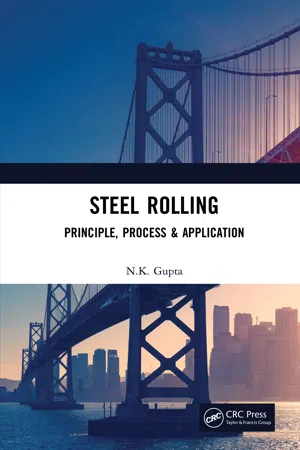
- 500 pages
- English
- ePUB (mobile friendly)
- Available on iOS & Android
About this book
This book covers all aspects and elements of rolling technology in one volume with even the most technical jargon being communicated in an easy to understand language. The book is exhaustive as topics ranging from rolls, rolls cooling, roll turning, roll reclamation, investigation of roll breakage, roll management and roll bearing all have been dealt in detail as these constitute the most important element of production cost. A separate chapter has been dedicated to operational management of a rolling mill, which includes safety and inventory. Packaging of the finished products and modern operating mill practices and technologies are also discussed in detail. This book will be a useful tool for shop floor personnel and for all senior management operating in the rolling mill industry; it is also a must read for all polytechnic / engineering students of metallurgical / mechanical / process engineering.
This book may also be useful as reference book for students/professionals of rolling technology.
Note: T&F does not sell or distribute the Hardback in India, Pakistan, Nepal, Bhutan, Bangladesh and Sri Lanka.
Frequently asked questions
- Essential is ideal for learners and professionals who enjoy exploring a wide range of subjects. Access the Essential Library with 800,000+ trusted titles and best-sellers across business, personal growth, and the humanities. Includes unlimited reading time and Standard Read Aloud voice.
- Complete: Perfect for advanced learners and researchers needing full, unrestricted access. Unlock 1.4M+ books across hundreds of subjects, including academic and specialized titles. The Complete Plan also includes advanced features like Premium Read Aloud and Research Assistant.
Please note we cannot support devices running on iOS 13 and Android 7 or earlier. Learn more about using the app.
Information
1
Roll Pass Design
1 INTRODUCTION

2 ROLL PASS DESIGN
2.1 Object of Roll Pass Design
2.2 Basic Purpose of Roll Pass Design
- To shape the metal to the designed profile.
- The profile design indicates a system of consecutive passes to produce the profile to the desired size and shape within the stipulated tolerance limit and with the specified mechanical properties and surface finish.
- Pass design also provides the shape and size of changing cross section of rolled material at every rolling stage.
- It locates the passes on the roll by designing rolls, working and non-working collars and also specifies the roll material etc.
- Pass design provides the highest possible production capacity of the rolling mill with minimum cost of rolled production.
- Pass design also ensures the smooth entry and exit of the strip and guaranteed the strength of rolls and motor capacity.
2.3 Characteristics of Efficient Roll Pass Design
- To make a profile with a smooth surface and of a correct dimensions within the stipulated limits of standard.
- To ensure the minimum expenses of energy, power and roll consumption.
- To give deformation in such a way to generate minimum internal stress in the finished product.
- To create a simple and convenient work culture in shop floor of rolling mill, which has to minimize the manual operation to the minimum possible extend to introduce the automation of technological process.
- To optimize number of passes, which required for rolling, to reduce the total rolling time cycle, with the minimum time spent for changing and adjusting of rolls.
2.4 Specified Conditions Under Which Roll Pass Design is Based Upon
- Characteristics of finished product i.e., dimension of section, tolerances and specifications concern to mechanical properties and surface finish of rolled product.
- Characteristics of initial input material i.e., dimension and weight of billet, grade of steel and the metal temperature before a...
Table of contents
- Cover
- Half Title
- Title Page
- Copyright Page
- Dedication Page
- Preface
- Acknowledgement
- Brief Contents
- Detailed Contents
- 1. Roll Pass Design
- 2. Mechanical Working and Rolling Process
- 3. Rolls, Roll Cooling and Roll Management
- 4. Rolling of Blooms and Slabs
- 5. Rolling of Billets
- 6. Rolling of Rounds and TMTS Bars
- 7. Rolling of Flats and Squares
- 8. Rolling of Angles
- 9. Rolling of Channels
- 10. Rolling of Beam
- 11. Rolling of Rail
- 12. Operation, Safety and Quality Management
- 13. Packaging of Steel Products
- 14. Energy Efficient Practices and Technologies
- Index